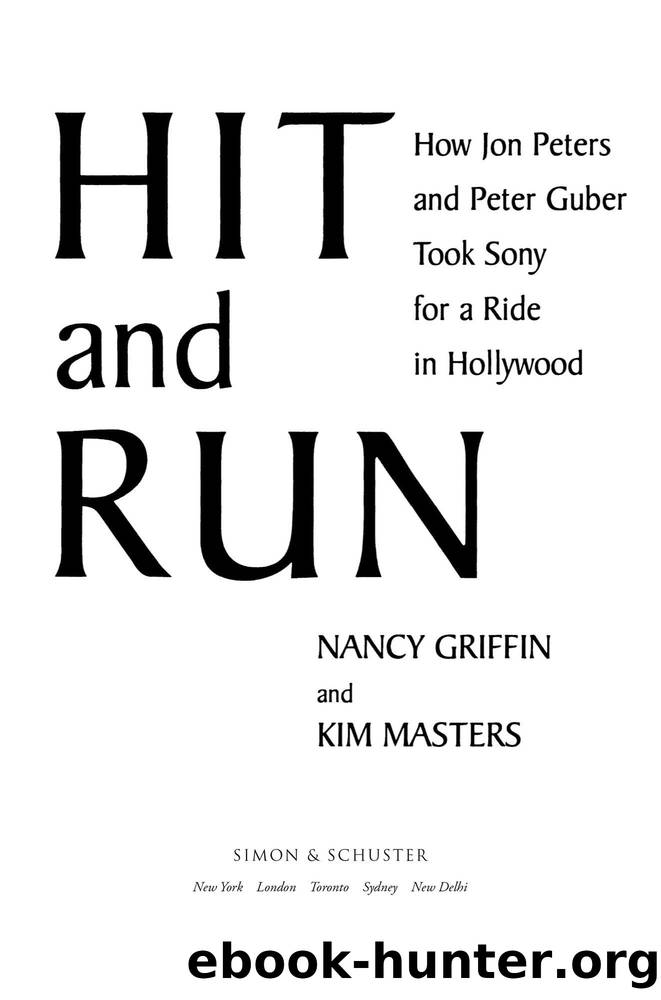Hit and Run by Nancy Griffin & Kim Masters

Author:Nancy Griffin & Kim Masters [Griffin, Nancy]
Language: eng
Format: azw3
Publisher: Simon & Schuster
Published: 2016-01-11T16:00:00+00:00
21
WHINE AND ROSES
HAVING REACHED the mountaintop, Jon Peters attacked his biggest decorating project ever: the renovation of the old MGM. He and Guber set about pouring hundreds of millions of Sonyâs dollars into making Columbia Picturesâ new home in Culver City as grand as possible, despite its unglamorous West Washington Boulevard location.
In February 1990, a COLUMBIA STUDIOS sign in big blue letters had been mounted over the main Madison Avenue gate. The new studio chiefs made much of the dilapidated condition in which they found their new digs. âRats! There were rats everywhere!â Jon Peters exclaimed.
The forty-four-acre lot was indeed a faded beauty. Many classic films, including The Wizard of Oz, had been shot there in MGMâs heyday. Now, it was a collection of shabby soundstages and bungalows. Its most elegant structure was the four-story Art Deco Thalberg Building, just inside the main gate, built in 1937 to honor Louis B. Mayerâs brilliant head of production, Irving Thalberg. In fact, Peters and Guber had sat together on the Thalberg Building steps one Sunday afternoon in 1988, commiserating over the dissolution of their short-lived bid to buy MGM.
In recent years the lot had changed hands several times. The Turner Broadcasting System acquired it from Kirk Kerkorian in 1986 but sold it later that year to Lorimar Pictures. Warner picked it up in 1989 when it acquired Lorimar.
Peters and Guberâs tiny principality could never rival Steve Rossâs 144-acre fiefdom at Warner. But if they couldnât have the biggest lot, they could try to have the best. Jon Peters vowed to âturn an empty shell into a jewel box.â
Culver City officials were known for their restrictive attitude toward development; there were many zoning regulations on the books intended to preserve the cityâs historic nature. No structure could be taller than four stories. Any plans for renovation or new construction on the lot had to be approved by the Planning Commission and the City Council. Some studio buildings on the property had been earmarked for preservation. When Sony arrived, the local citizens were suspicious of any changes the Japanese company wanted to make.
Peters, impatient about getting the studioâs facelift underway, put the renovation plans into high gear. Amid jokes that Columbia soon would be transformed into a land of koi ponds and mini-amusement parks, Jon recruited Anton Furst, Batmanâs production designer, to help him redesign the lot. Furst was in New York early in 1990 working for Penny Marshall on Awakenings. In April he would win an Academy Award for his art direction on Batman.
Jon had big plans for Furst, whom he recognized as an uncommonly charismatic talent. He wanted the designer to relocate from London to Los Angeles, help him spiff up the lotâand then make his debut as a film director.
Furst moved to Los Angeles in the summer. He established the Furst Company in a decrepit freestanding Spanish bungalow on the lot called the Joan Crawford Building. With his long hair and jeans tucked into knee-high motorcycle boots, Furst didnât strike corporate types like Alan Levine as an appropriate custodian of the massive lot renovation.
Download
This site does not store any files on its server. We only index and link to content provided by other sites. Please contact the content providers to delete copyright contents if any and email us, we'll remove relevant links or contents immediately.
Machine Learning at Scale with H2O by Gregory Keys | David Whiting(4104)
Never by Ken Follett(3761)
Harry Potter and the Goblet Of Fire by J.K. Rowling(3758)
Unfinished: A Memoir by Priyanka Chopra Jonas(3313)
Fairy Tale by Stephen King(3192)
The Man Who Died Twice by Richard Osman(2977)
Will by Will Smith(2769)
Rationality by Steven Pinker(2271)
The Dark Hours by Michael Connelly(2216)
It Starts With Us (It Ends with Us #2) by Colleen Hoover(2173)
The Storyteller by Dave Grohl(2149)
Can't Hurt Me: Master Your Mind and Defy the Odds - Clean Edition by David Goggins(2146)
The Dawn of Everything: A New History of Humanity by David Graeber & David Wengrow(2103)
Friends, Lovers, and the Big Terrible Thing by Matthew Perry(2099)
The Becoming by Nora Roberts(2061)
The Stranger in the Lifeboat by Mitch Albom(2031)
Cloud Cuckoo Land by Anthony Doerr(2012)
Einstein: His Life and Universe by Walter Isaacson(1952)
Love on the Brain by Ali Hazelwood(1931)
